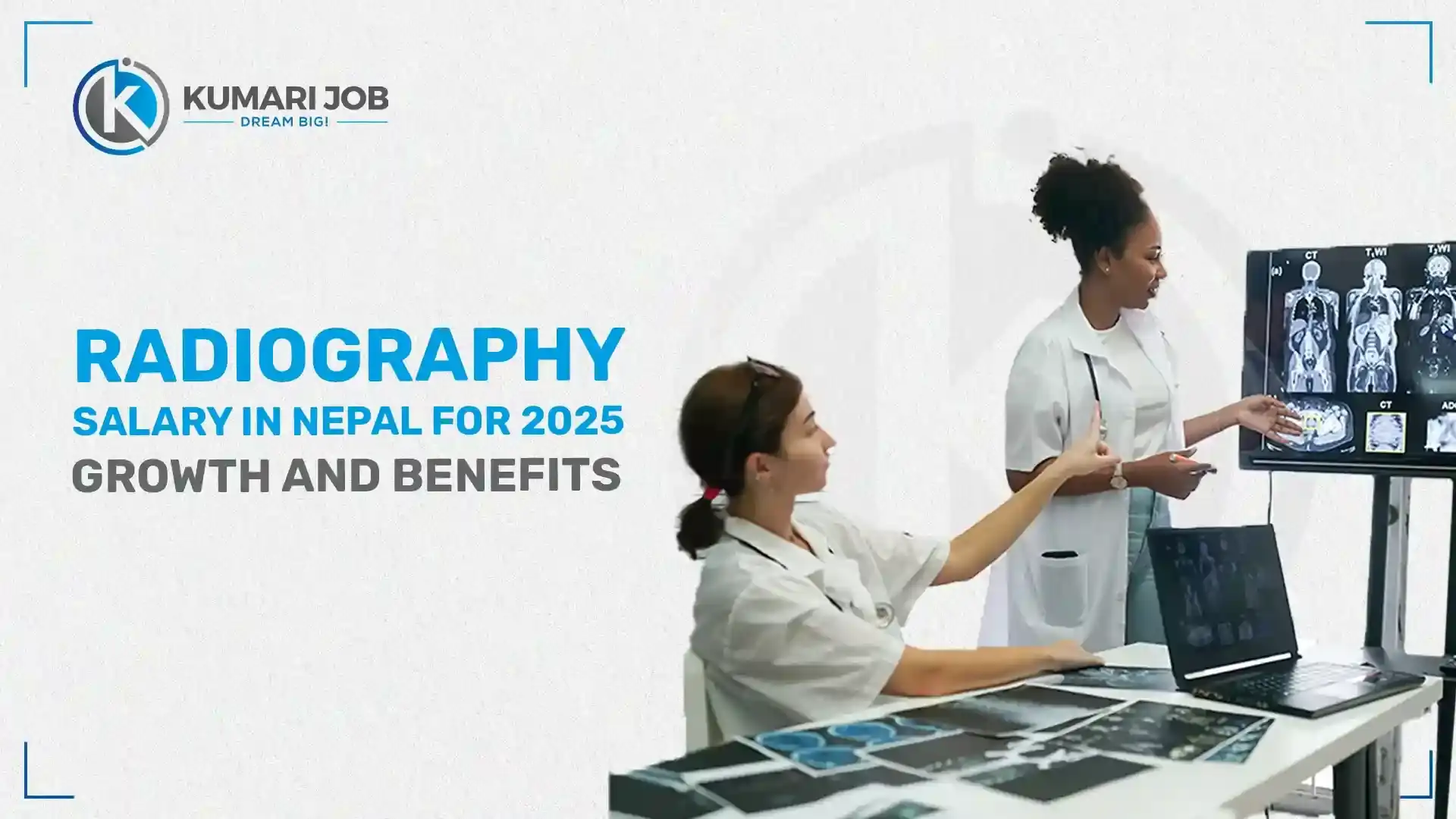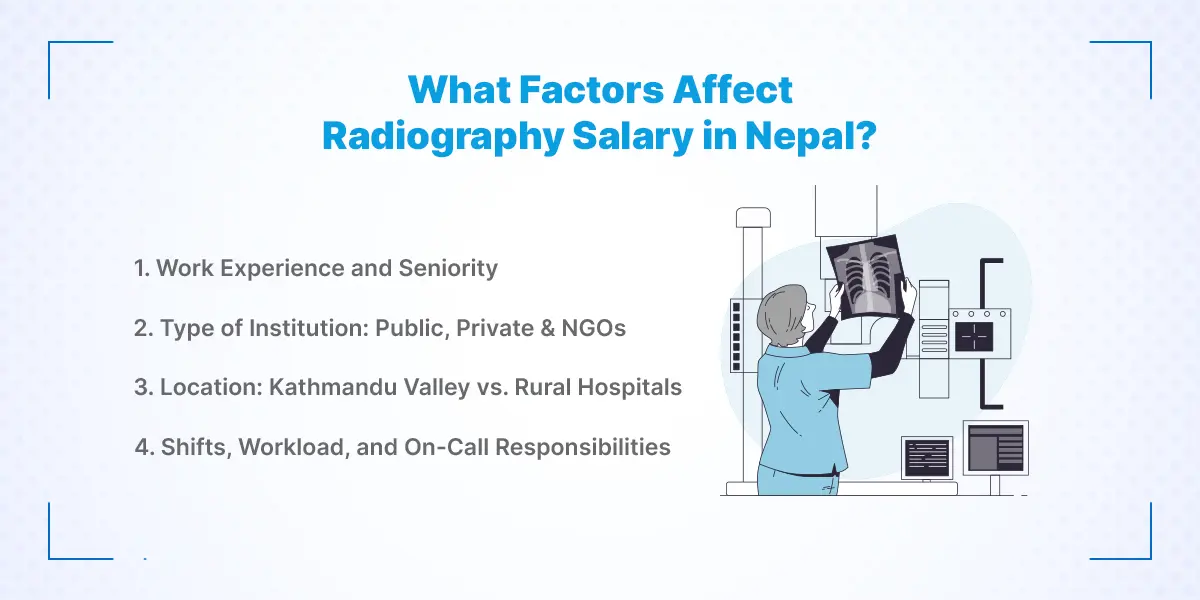
Have you ever thought about how much radiographers actually earn in Nepal? As hospitals grow and medical diagnostics go more advanced, radiographers are increasingly becoming an important part of the healthcare profession. However, many people still have no idea what kind of salary their profession offers, especially in 2025.
Whether you're a student considering radiography as a career option or an existing professional seeking to change your career path, learning about salary trends is crucial. In this blog, we will explore the radiography salary in Nepal, how experience and qualifications influence your salary, and the benefits and growth opportunities you can expect in this rewarding field.
In this blog
- What is Radiography and What do Radiographers do?
- What is the Salary of Radiographers in Nepal?
- Want to Explore More Medical Jobs in Nepal?
- How Qualification Impacts Radiographer Salary in Nepal?
- What Factors Affect Radiography Salary in Nepal?
- Career Growth Opportunities for Radiographers in Nepal
- Why Choose Radiography as a Career in Nepal?
- Benefits and Perks Beyond Salary
- How to Increase Your Salary as a Radiographer in Nepal?
- Conclusion
- Frequently Asked Questions
What is Radiography and What do Radiographers do?
Radiography is a medical field that uses imaging technology to see what is happening in the human body. Radiography helps doctors diagnose injuries, diseases, or conditions by creating images using X-rays, CT scans, MRIs, or ultrasounds. The process is safe, quick, and non-surgical, which means no surgery is needed. Radiography is used in almost all hospitals, clinics, and diagnostic centers in Nepal. Physicians would not be able to treat patients properly without it.
These imaging procedures are performed by radiographers. You might have heard them called X-ray technicians or medical imaging technologists. They prepare patients for scans, operate the equipment, capture high-quality images, and occasionally assist doctors in interpreting results. They ensure that equipment works properly and monitor safety precautions, particularly to prevent patients from receiving excessive radiation. Essentially, they are an important part of patient care behind the scenes.
One area of confusion is between radiographers and radiologists, but they are not the same thing. Radiographers are the ones who actually use the machines to take the photographs. Radiologists are doctors who look at the photographs and give a diagnosis of what they see. So, although both are close partners in the imaging process, one takes the pictures, and the other interprets the pictures. You could think of it as a photographer and a photo editor.
Radiography can also be called diagnostic imaging or medical imaging. It includes methods like X-ray, ultrasound, CT, and MRI. All these fall under radiologic technology. With hospitals in Nepal continuing to modernize equipment and services, the need for trained radiographers is increasing. It's a career that meets the fields of technology, health care, and patient care, hence making it both practical and rewarding.
What is the Salary of Radiographers in Nepal?
The average monthly salary of radiographers in Nepal usually ranges from NRs 25,000 to NRs 60,000, depending on experience, qualifications, and location of work. On an annual basis, this is approximately NRs 300,000 to NRs 720,000. Just keep in mind that these amounts can be different depending on where you work and how many years' experience you have.
1. Average Monthly and Annual Salary Ranges in NPR
For fresh graduates or starting-level radiographers new to their profession, the average monthly salary is typically between NRs 20,000 and NRs 30,000. This may be the case in smaller clinics or hospitals where the patient volume is moderate. Once you have gained experience and developed your skills, your pay will increase. With 4 to 5 years of experience, radiographers can expect to make between NRs 40,000 and NRs 60,000 or even higher per month, especially if they have specialized skills like CT or MRI operation.
On an annual basis, these amounts translate to roughly NRs 240,000 to NRs 720,000, depending on your level of experience and the organization. Bonus, overtime, or additional perks can also add to this basic salary.
2. Entry-Level vs. Experienced Radiographer Salaries
Beginning your career as a radiographer in Nepal will earn you the entry-level salary scale. In these starting positions, you will receive training to help you familiarize yourself with various equipment and patient handling. However, there's no need to worry as salaries typically increase as you gain experience and further qualifications.
Senior radiographers take on additional responsibility within a few years, such as supervising imaging equipment, junior staff, or specializing in ultrasound or MRI areas. The added skills most definitely help with additional pay. Employers value dependability and skill acquisition, leading to salary increments and career advancement. Experience serves as a pathway to higher salaries in the profession.
3. Private Hospitals Vs Government Employment
Another crucial factor that determines your salary as a radiographer in Nepal is where you work. Government hospitals tend to offer secure jobs with fixed pay and benefits like pension schemes, paid leaves, and health insurance. The salary in government service could be a little lower, typically between NRs 20,000 and NRs 35,000 per month for radiographers.
Diagnostic centers and private clinics may offer better compensation, especially in urban areas like Kathmandu. They prefer skilled experts and compensate them more for night shifts or overtime. Private sector radiographers with advanced-level skills can earn more than NRs 50,000 to 60,000 monthly. Private employment, however, might be less secure in terms of job and benefits compared to government employment.
Want to Explore More Medical Jobs in Nepal?
Browse a wide range of healthcare and medical job openings including radiography, nursing, lab technician, and more. Apply today!
How Qualification Impacts Radiographer Salary in Nepal?
Regarding radiography salary in Nepal, your qualifications and education play a major role in determining how much you earn. Let us analyze how different qualifications affect your salary.
1. Diploma Holders vs. Bachelor's Degree Holders
In Nepal, most of the radiographers start their career with a diploma in radiography from places like CTEVT. The diploma is finished in about 3 years and includes the basics of working with imaging machines like X-rays and ultrasounds. Diploma holders can find jobs relatively quickly, especially in clinics or small hospitals.
On the other hand, when it comes to payment, diploma holders receive lower pay compared to those with a bachelor's degree. A Bachelor of Radiography or Medical Imaging Technology typically takes 4 years and is more specialized, for example, in advanced imaging techniques and patient care. With this extra training, bachelor's degree holders tend to be favored by larger hospitals and diagnostic centers that prefer to pay them more. They also have better opportunities for promotion and specialty posts.
Thus, if you have a diploma, you're already ahead, but getting a bachelor's degree will move you to more financially rewarding pay and better career opportunities.
2. Impact of Foreign Degrees or Certifications
Another feature that can boost your pay is having a foreign degree or a certification. While some radiographers choose to pursue their studies abroad, for example, in India, Australia, or the Middle East, others get internationally recognized certifications such as ARRT (American Registry of Radiologic Technologists).
Having a foreign qualification is often equivalent to having developed skills or technologies in higher demand. In Nepal, such qualifications are ranked high by employers, especially private hospitals and foreign clinics, and could even be provided with higher pay to hire such experts. To add to that, foreign-certified radiographers have it easier to find work abroad, where salaries are also higher.
So, if you’re aiming for a better salary or international work experience, investing in foreign education or certifications can be a smart move.
3. Role of Specialization (CT, MRI, Ultrasound)
Not all radiographers do the same kind of imaging. Some only specialize in specific types of scans, like CT (Computed Tomography), MRI (Magnetic Resonance Imaging), or ultrasound. Those are usually better paid but need some extra training and certification.
Why? Because machines like MRI and CT are complex and expensive, only a few radiographers have the knowledge to operate them. Hospitals and diagnostics centers are happy to pay a premium to radiographers who are capable of handling these high-tech machines, especially in cities like Kathmandu.
Specialization can also mean more job security as well as improved career growth. Thus, if you are looking to earn more money in Nepal, learning and certifying in specialized imaging techniques is a great choice.
What Factors Affect Radiography Salary in Nepal?
The radiography salary in Nepal depends on various important factors like your level of experience, workplace type, geographic location, and even your shift or workload. Let us examine each one of these more closely.

1. Work Experience and Seniority
A big deciding factor in salary is experience. Like any other profession, the more you work, the higher your salary will be. Your starting salary will likely be around NRs 20,000 to 30,000 per month if you are a fresh graduate or have recently completed your diploma or bachelor's degree. This is normal in entry-level jobs, especially in smaller clinics or outside the Kathmandu Valley.
But after 3 to 5 years of experience, your salary generally increases. Most radiographers by this time are experienced enough to operate more complex machines, lead departments of imaging, or teach junior colleagues. Salaries at this stage can be as much as NRs 40,000 to 55,000 a month.
For senior radiographers with greater experience of over 7–10 years, especially those working at high-end private hospitals or teaching hospitals, salaries can reach NRs 60,000–70,000+ per month. Some also receive extra earnings from part-time work at private diagnostic centers.
2. Type of Institution: Public, Private & NGOs
Where you work is also a massive factor in how much you earn. Radiographers in Nepal are employed in government hospitals, private hospitals, NGOs, and diagnostic centers, and all of them are paid differently.
Government hospitals pay less initially (NRs 20,000–35,000) but come with benefits like job security, pension, paid leaves, and insurance. Government jobs are a good choice if you value stability, even though the salary isn't that great.
Private hospitals tend to pay more, especially those in bigger cities. Salaries for experienced radiographers here tend to be between NRs 40,000 and may even be NRs 70,000 or more, depending on your experience and qualifications. Benefits may be less here, and there may be less job security.
NGOs or international health projects sometimes pay the highest. Organizations working in maternal health or rural imaging services often hire radiographers for short-term contracts and may pay well, sometimes even higher than private hospitals, especially if you’re working in a remote location.
Example: A radiographer working in a remote health project run by an international NGO might earn NRs 60,000+ per month, including field allowances.
3. Location: Kathmandu Valley vs. Rural Hospitals
Geography also plays a role in salary. Radiographers who work in Kathmandu or other big cities are likely to get better pay than those who work in rural or district hospitals.
In urban areas like Kathmandu, Pokhara, or Biratnagar:
There are more private hospitals and diagnostic centers
Demand for radiology services is high
Competition leads to better salary packages
On the other hand, rural hospitals or health posts may have fewer pieces of equipment, attend to fewer patients, and have lower budgets. Salaries in rural areas are frequently NRs 5,000–15,000 lower than those in urban areas. Some rural jobs, however, do offer housing or travel allowances as compensation.
That being said, rural employment remains an excellent way to gain experience in a short space of time, especially if you're starting out.
4. Shifts, Workload, and On-Call Responsibilities
Radiographers occasionally work shifts, which can also impact their earnings. Private hospitals tend to operate 24/7 imaging departments, so you may be expected to perform night shifts or be on-call during holidays.
Night shifts or on-call emergencies generally carry extra pay or allowances.
You may have a greater workload if you're the only radiographer on duty, especially in smaller facilities, but overtime pay can be higher as well.
On the other hand, in government fixed-hour hospitals, the work hours are more regular, yet shift extra pay is rare.
Example: A radiographer working night shifts in a private hospital in Kathmandu can receive an additional NRs 5,000–10,000/month as shift allowances.
Career Growth Opportunities for Radiographers in Nepal
Radiography is not only a job. It can be a career with real growth, both nationally and internationally. If you're new to the field or considering a career in this area, it's helpful to know how far you can advance and what opportunities are available after gaining some experience.
1. Promotion Paths: From Technician to Senior Roles
Most of the radiographers in Nepal start out as X-ray technicians or junior imaging staff. With a little time and experience, you can move up to senior radiographer, department in-charge, or even supervisor at hospitals or imaging centers.
Promotions rely on your experience in the job, ability, and performance in handling the responsibility. If you are in a big hospital, you might also be the leader of a few others or serve as a mentor to junior staff. These senior positions have better pay, more respect, and leadership experience.
2. Advanced Studies: M.Sc. and Higher Certifications
If you want to grow academically as well as professionally, pursuing further studies is a good choice. After you have your B.Sc. in Medical Imaging or Radiography, you can appear for a Master's degree (M.Sc.) in Radiology or Medical Imaging. This increases your knowledge and offers prospects for becoming a teacher or a high-level post in colleges or hospitals.
You can also benefit from short-term certifications in higher imaging technologies like CT, MRI, and ultrasound. They are highly paid jobs in Nepal, and companies even pay more to the radiographers with these qualifications. Even if you don't want to go for a full Master's, attending one or two courses of certification can make a huge impact on your career.
3. Opportunities Abroad: Gulf, Australia, Europe
A majority of Nepali radiographers wish to work abroad, and it's definitely possible. The UAE, Qatar, Saudi Arabia, and Kuwait frequently hire radiographers in Nepal, particularly those with experience and training. Salaries in these countries are much higher, and many hospitals offer free accommodation and transport.
If you have superior qualifications and global registration (like ARRT or HCPC), you can even secure Australian, UK, or other European jobs. They usually require passing language tests (like IELTS) and license tests, but they are totally worth it in terms of salary and quality of life.
Why Choose Radiography as a Career in Nepal?
If you're looking for a healthcare career that combines technology, hands-on work, and patient care, radiography is a path worth exploring. Radiographers play a vital role in helping doctors diagnose and treat illnesses through medical imaging. It’s a profession that’s becoming more important every year, especially as Nepal’s healthcare sector continues to grow.

1. High Demand for Skilled Professionals
The health sector in Nepal has expanded significantly over the past few years, with an increasing number of hospitals, clinics, and diagnostic centers opening at an accelerated pace, particularly in urban areas such as Kathmandu, Pokhara, and Butwal. With growth comes a higher demand for X-ray, ultrasound, CT, and MRI machine–operating radiographers.
With more and more people seeking precise medical diagnosis, radiographic imaging has become the main point of health services. This means that hospitals are constantly searching for trained imaging technicians to hire, and new graduates easily find jobs within a couple of months of graduation.
2. Job Stability and Reasonable Starting Pay
Unlike some other jobs, radiography is a stable and solid career. Almost all private and public hospitals need radiographers. And since imaging is an important part of diagnosis and treatment, this job is not fading away anytime soon.
You don't need to wait years before you can start making money. You can start at NRs 20,000–30,000 a month, even with just a diploma, without waiting months for placement. Government jobs may begin a bit lower at first, but with pension, medical cover, and job security.
Private hospitals and clinics will give you a higher starting salary and quicker salary progression, as long as you are prepared to take on extra work like weekends or night shifts.
3. Skill-Based Income Growth Opportunities
One of the greatest things about being a radiographer is that you earn more as you get better. If you can operate complex equipment like CT scanners, MRIs, or perform ultrasounds, then you earn more. These are highly desirable skills, but only a few have them. So if you specialize, then you earn more and you get noticed in relation to everyone else.
You can also work part-time in diagnostic centers or on-call duty to supplement your income. A few radiographers open up small clinics of their own in their hometown after gaining considerable experience and saving some capital.
Benefits and Perks Beyond Salary
Radiography is not just about earning a monthly paycheck. There are also additional benefits that come with it, which make the profession comfortable, safe, and fulfilling. Whether you work in a government setup or a private hospital, there are some extra benefits that can really improve your professional as well as personal life. Let us see some of the most common ones.
1. Medical and Health Insurance Coverage
The majority of hospitals in Nepal offer health insurance to their workers. This means that if you fall sick or need treatment, the hospital or insurance plan will help pay for it. Certain hospitals even cover your families, e.g., spouse or parents. This is especially helpful in case of emergencies or working in a high-risk field like radiology. Medical insurance not only pays off in the short run but also provides peace of mind in knowing you're covered while you're working.
2. Government Pension Schemes
If you work for a government hospital, the pension system is one big plus. Even after retirement, you will receive a fixed monthly amount for the rest of your life. It is, therefore, attractive for most people as it offers future security. While private hospitals generally do not offer pensions, they might offer some end-of-service allowance. Nonetheless, if you want security after retirement, the government sector has a big plus point on this front.
3. Paid Leave, Bonus, and Overtime Pay
The radiographers employed in the government and private hospitals are offered paid leaves like annual leave, sick leave, and festival holidays. This enables you to relax, enjoy with your family, or solve personal problems without loss of pay. The hospitals also offer bonuses during Dashain, Tihar, or the New Year as a token of gratitude towards their employees. If you work overtime, like night shifts or emergencies, you might get overtime pay as well, especially in private hospitals. These small extras do add up in the long run.
4. Professional Recognition and Work Environment
Radiographers are an important part of the health care team. Your professional input helps doctors diagnose and treat patients immediately. Hospitals appreciate this role and give professional recognition to experienced or skilled radiographers. You can have the chance to attend training programmes, workshops, or even train junior staff. Having a job where you belong to a team and your work counts can make what you do more satisfying and meaningful. A good working environment also contributes significantly to the pleasure one can gain from one's profession.
How to Increase Your Salary as a Radiographer in Nepal?
To increase your salary as a radiographer in Nepal, focus on improving your skills, gaining experience in strong institutions, and picking up extra shifts where possible. Each step not only raises your income but also builds a stronger, more stable career in the long run.
1. Get certified in CT, MRI, or Ultrasound
One of the fastest ways to increase your salary is to get certified in specialty imaging technologies like CT (Computed Tomography), MRI (Magnetic Resonance Imaging), or Ultrasound. It takes skill to operate these machines, and not every radiographer is trained to work with them, which increases your worth.
Hospitals and diagnostic centers are ready to offer higher salaries to professionals who can handle more than one machine confidently. Even a short 3–6 month training program can lead to better job opportunities or promotions. For example, an X-ray technician who began his career for NRs 25,000 can increase his salary to NRs 45,000 or more after training in CT/MRI.
2. Get Experience in Top Hospitals
Experience goes a long way in this field. The more years you work, the more proficient and confident you become, and that typically translates to better-paying job offers. But where you gain that experience also matters.
Working in well-established hospitals or diagnostic centers, especially in cities like Kathmandu or Pokhara, not only increases your skills but also improves your CV. Employers also prefer to offer better pay to the radiographers with established experience in busy or well-equipped centers.
If you are new, even a job in a smaller clinic can be the starting point. But over time, try to switch over to better institutions where you'll get exposure to newer equipment and a chance to learn from senior teams.
3. Take On Extra Shifts or Part-Time Work
Another practical way of earning extra income is to take extra shifts or freelance. It is common for most radiographers in Nepal to earn extra income by working in various clinics or working on-call in private diagnostic centers on weekends or evenings.
Some hospitals provide overtime compensation, particularly for nights or holiday work. It may become somewhat tiring at times, but even working a few more hours a week can significantly add to your monthly income.
For example, the hospital radiographer in Nepal who earns NRs 40,000 per month can earn an extra NRs 10,000 in a month working weekend ultrasound shifts at a nearby clinic. It adds up in the end and gives you more savings or purchasing power.
Conclusion
Radiography is a rewarding and respected career in Nepal, especially if you’re someone who wants to work in healthcare but prefers a more technical, hands-on role. While the starting salary may seem a bit low, there are numerous opportunities for growth through experience, advanced training, or even working abroad. The demand for skilled radiographers is expected to rise as healthcare services expand nationwide.
If you're ready to continue learning, specialize, and make informed choices, this career can not only provide a stable income but also long-term career satisfaction. Whether you're starting your career or already working in the profession, radiography offers you the freedom to build a future that's stable, valuable, and full of opportunity.
Looking to start or grow your career in radiography? Browse the latest medical job openings in Nepal and apply today!







Loading Comments...